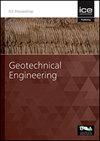Shear behaviour of infilled rock joints under different boundary conditions
IF 1.7
4区 工程技术
Q3 ENGINEERING, GEOLOGICAL
Proceedings of the Institution of Civil Engineers-Geotechnical Engineering
Pub Date : 2022-04-07
DOI:10.1680/jgeen.21.00060
引用次数: 0
Abstract
Recently use of commercial software for analysis and design of rock slopes, underground structures, mining projects, the foundation of any infrastructure projects, piles, etc. becoming more popular and widely used. But sometimes, this software has many limitations and cannot be used directly for finding out the strength and deformation behavior of rock joints when joints are subjected to external load because of the construction of different projects. Correct prediction of strength and deformation behavior of rock joints are important for safe, economical, and sustainable design. In the present work, strength and deformation behavior of unfilled and infilled rock joints have been studied numerically by using one of the commercial software Universal Distinct Element Code (UDEC) under different boundary conditions like constant normal stiffness (CNS) and constant normal load (CNL) boundary conditions. The numerical model results are compared with experimental results of the test performed on a physical model. The strength predicted by the numerical model is in close agreement with experimental results at low initial normal stress and for CNL boundary conditions, as the asperity degradation during shearing process is almost same throughout the test. The numerical model cannot correctly predict the shear strength of rock joints under CNS boundary conditions and at high normal stress for both CNL and CNS conditions, because of the degradation in the asperity during shearing process and available model dosenot consider this effect. Hence, UDEC code has been modified in the present study for its acceptability under both CNL and CNS boundary conditins and at high initial normal stress at CNL boundary conditions. A comparison of predicted value with experimental results indicated most of the prediction lies in the prediction bend of 95%.不同边界条件下充填岩体节理的剪切特性
近年来,利用商业软件对岩质边坡、地下结构、矿山工程、任何基础设施工程的基础、桩基等进行分析和设计越来越受欢迎和广泛应用。但有时由于不同工程的施工,该软件存在许多局限性,不能直接用于计算岩石节理在外力作用下的强度和变形行为。正确预测岩石节理的强度和变形特性对设计的安全性、经济性和可持续性具有重要意义。本文采用通用离散元代码(UDEC)软件,对不同边界条件下,如恒法向刚度(CNS)和恒法向荷载(CNL)边界条件下,未充填和充填岩石节理的强度和变形特性进行了数值研究。数值模型结果与物理模型试验结果进行了比较。在低初始法向应力和CNL边界条件下,数值模型预测的强度与试验结果吻合较好,因为在整个试验过程中,剪切过程中的粗糙度退化几乎相同。由于剪切过程中粗糙度的退化,现有的模型没有考虑到这一影响,所以无论是CNL还是CNS条件下,数值模型都不能正确预测CNS边界条件下和高法向应力条件下岩石节理的抗剪强度。因此,在本研究中对UDEC规范进行了修改,以使其在CNL和CNS边界条件下以及在CNL边界条件下的高初始法向应力下均可接受。预测值与实验结果的比较表明,大部分预测都在95%的预测弯曲范围内。
本文章由计算机程序翻译,如有差异,请以英文原文为准。
求助全文
约1分钟内获得全文
求助全文
来源期刊
CiteScore
4.40
自引率
4.50%
发文量
68
审稿时长
3 months
期刊介绍:
Geotechnical Engineering provides a forum for the publication of high quality, topical and relevant technical papers covering all aspects of geotechnical research, design, construction and performance. The journal aims to be of interest to those civil, structural or geotechnical engineering practitioners wishing to develop a greater understanding of the influence of geotechnics on the built environment.

 求助内容:
求助内容: 应助结果提醒方式:
应助结果提醒方式:


